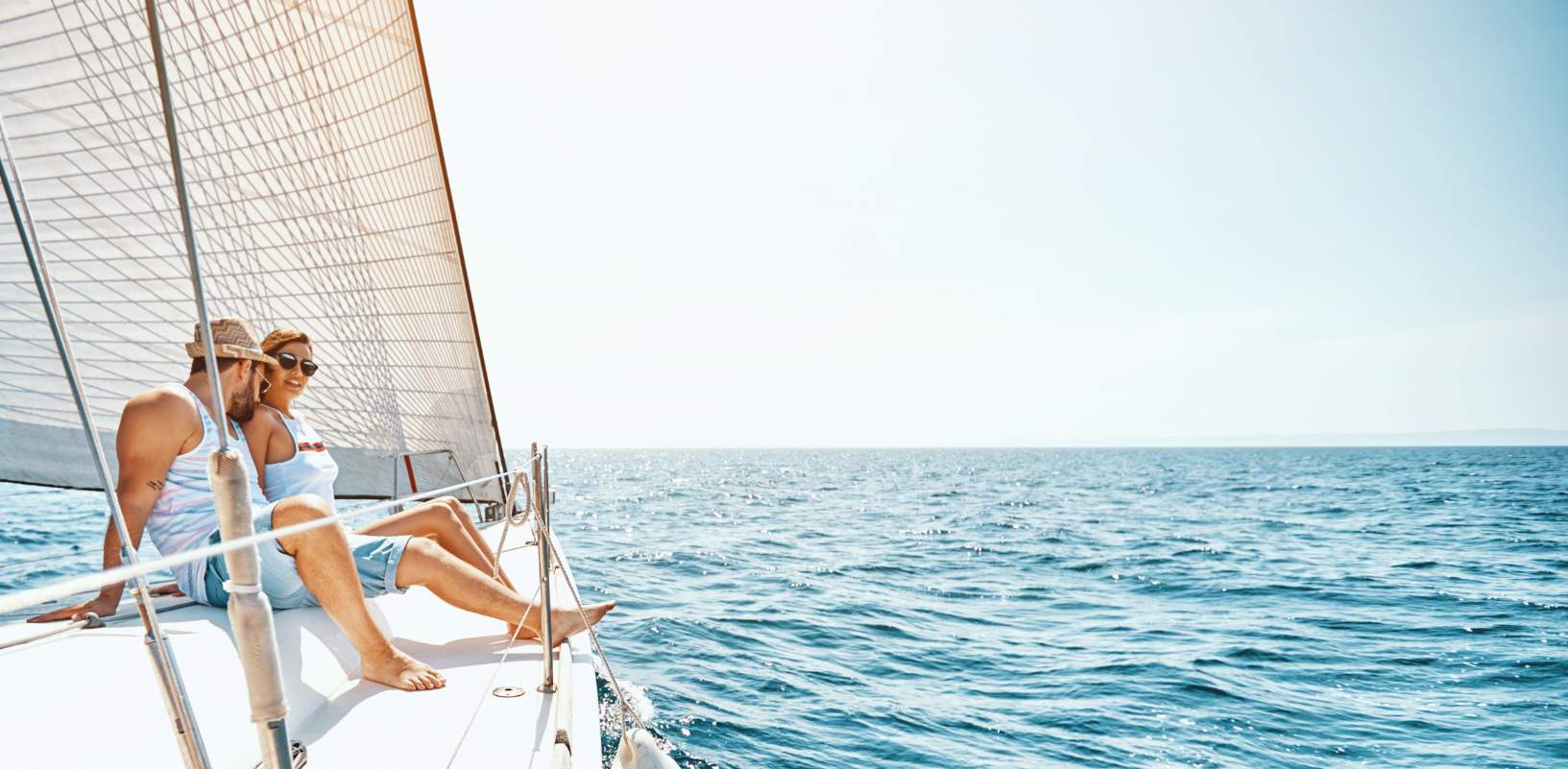What kind of vessel to choose?
First, you need to decide whether you will rent a sailing boat, a catamaran or a motor vessel. It depends on you whether you just want to navigate or whether you also want to enjoy under the sails and in the wind.
With each type of vessel, you need certain knowledge, with motor vessels as well as sailing boats, but if you know that your practical knowledge is not good enough, it is recommended that at least for your first few nautical holidays, you hire a skipper who will take care of navigation, routes, berths and everything related to the vessel.
In any case, we recommend you to rent a vessel of the size and with as many beds as the persons on the boat.
It is always more comfortable for the entire crew for each member to have his own bed, a cabin, which he can retreat to at any time.
It is true that it is possible to sleep comfortably in the salon, but let this be more of a reserve for visits, the skipper etc. The salon should be a place for socializing.
I have a license to operate the vessel and a GMDSS and radiotelephony certificate, but I do not have practical experience.
At sea, practical experience is extremely important and if you do not have it or you think you do not have enough of it, it is certainly advisable to hire a professional skipper or some acquaintance, a friend, who is skilled in navigation and who has such experience.
This way, you will be much more carefree and, at the same time, you will combine pleasant with the useful and with the help of a skipper, you will learn and gain practice for independent navigation.
When you pass the boat and radiotelephony exam, it is highly advisable to search for the courses for practical navigation for motor boats and sailing boats, for crew members and skippers, which give you the knowledge and experience for independent navigation.
Also, if you often participate in sailing and navigation as a crew member, you will always gain new knowledge and experience in a wide range of situations and weather conditions.
What is the cost of hiring a skipper?
The cost of a skipper is usually not included in the rental price of a vessel, it is charged per day and the price is around 125.00 EUR/day. Skipper is with you all the time, he sleeps on the boat, in the salon or in the cabin if all the beds are occupied; larger vessels have skipper cabins.
In addition to payment, you are obliged to provide food and beverage for the skipper, as well as for the entire crew. Also, if you go for a dinner in a tavern, the skipper usually goes with you. The same applies if you (also) hire a hostess, but her job is serving, cooking, cleaning, etc.
What does a skipper do?
First and foremost, he operates the vessel, takes care of sailing out, navigation, berthing, he arranges with the crew about the routes and destinations, the visits to which to a large extent depend on weather conditions.
He also takes care of the technical part of the vessel's management. He helps and advises the crew on locations, makes sure your holiday is safe, gives the crew instructions for helping with sailing out and/or berthing, helps with registering in marinas and ports, takes care of pouring water and fuel into tanks.
However, the skipper is not responsible for taking care of children, household work, cleaning inside the boat, etc., nor is he bound to contribute to the shared expenses for berths, food and beverages. Instructions given by a skipper must be implemented and respected, because he is responsible for the safety of a vessel and the crew who has no experience.
The renter of a vessel is obliged to pay caution money, despite hiring a skipper. The potential damage caused by the crew is covered from the caution money.
What clothes to wear on board?
Depending on the time of the year in which you will sail. Comfortable, sporting wardrobe should prevail. If you sail in the hot summer, you will not need many clothes – swimwear, shorts, t-shirts and sports shoes (sailing) or you can be barefoot on board, otherwise you will need sandals or flip flops on land.
If you are a hiker, be sure to have good mountain shoes with you since the Adriatic islands and the coastline have many peaks that you can visit when you berth a boat or you dock on a specific destination. Otherwise, even in the summer, it is necessary to have some warm clothes with you, as well as anoraks, waterproof jackets and trousers, caps, etc.
On the coast, on the pier, it may feel warm and windless, but as soon as you sail out, the wind is stronger, the feeling can quickly be cooler and an anorak or a tracksuit can come in handy.
In the pre-season and after-season, such wardrobe is mandatory, sailing suits that are resistant to moisture, rain and wind are advisable so that you will not be quick to feel uncomfortable in the wind or get cold.
Warm caps and gloves are also obligatory; sailors practice with sail gloves, where their fingers are outside.
Then, of course, there is underwear, socks, t-shirts, tracksuits and so on.; the everyday wardrobe, you wear at home. For spring and autumn sailing, suitable shoes are sports shoes with white soles, so that they do not leave black trails on the boat, or proper sailing shoes and in the case of rainy weather, rubber sail boots.
Do not let it deceive you – no matter how hot it feels on the shore, the wind is stronger and colder at sea; it is not comfortable to sail cold and wet.
What about food and beverage on board?
Kitchens on boats are equipped so that you can prepare all meals – gas burners, on larger boats even ovens, refrigerators are sized proportionate to vessels.
You will not be able to put all your food and beverages in the refrigerator for 7 or 14 days of sailing, but the storage spaces and drawers are designed for this purpose everywhere on the boat.
Of course, it takes a bit of effort and time to fold and store everything in a useful manner when boarding, but then we have no problems with searching what we need. It is a good idea to plan ahead for each day, what will be on the menu and buy a right amount of food.
More durable foods that are quickly prepared, canned foods and food in sachets, etc. is usually taken on board. Fresh foods, especially in the summer heat, are usually perishable, especially because there is no room for the entire supply in the refrigerator and because you prefer to cool the beverages there; therefore, this type of foods should be used first.
If you do not bring food and beverages with you, you can buy them in a market where your starting marina is or you can buy it when you need it, depending on where you will sail and how you plan the stops.
In a cosy, lonely bay, you will find it difficult to buy fresh bread and water ... however, you may actually find it, because entrepreneurial locals offer many things from boats (market boat etc.).
You will certainly plan a lunch or dinner at some point in one of the many restaurants or taverns during your sailing.
Otherwise, you can also order and buy food, sweets, kitchen utensils and beverages on the website www.jamyachtsupply.com.
How about bedding, towels?
You do not need to have this with you, bed linen and towels are waiting for you on the vessel. Perhaps you can bring a spare, larger bath towel, which also serves for lying on the deck.
Where can you park?
Marinas have arranged enclosed parking spaces that are more or less supervised (but they are usually not liable for possible damage to vehicles). Prices per day vary from 7.00 to 12.00 EUR/day. In high season, parking spaces may be fully occupied, so you will be forced to search for a parking space outside the marina.
In the vicinity of the marinas, you can park in outdoor parking lots or in the blue zone where you can also pay the parking fee in advance for 7 days or more. Such parking fee is also cheaper than parking in the marina.
Check in, check out – boarding, disembarking?
Usually, the charter operators’ practice is that you take over the vessel after 5 p.m. (CHECK IN) and return it by 9 a.m. on the last day (CHECK OUT). It largely depends on the season and crowd. Somewhere at peak, in the middle of July and August, it will be difficult to get the vessel sooner. Some charter operators offer the opportunity to express the wish of early boarding (e.g. at 1 p.m.), but such a service is charged (e.g. 100.00 EUR); the service is also limited (for example, to 5 vessels) because it is simply impossible with the staff they have at their disposal to inspect all the vessels in the fleet, clean them and prepare them for another guest.
Check in is performed by the assigned skipper charter of the operator and at least one crew member who is renting a vessel, according to protocol – a careful inspection is recommended, all imperfections, any observations of damage and shortcomings must be recorded if you discover that something is wrong, because otherwise you will be the one who covers the defects and damages from the security deposit.
When you sign the record, you are finished with the takeover and you can sail out as you have planned.
Check out is also performed by both – the skipper charter of the operator and a crew member, everything is again inspected and recorded and this time, the person inspecting on the side of the charter will be very careful.
It is right that you also point out the shortcomings you find and especially if anything happened to the vessel, malfunctioned, broke down or if you lost some part of the equipment that could affect the navigation of other customers.
They would discover if anything was wrong with the vessel anyway and it does not make sense to send any bills and recoveries later. The underwater part of the vessel will certainly be inspected by a diver and until he performs an inspection, check out will not be completed.
Furthermore – the practice is that you return to the base marina already in the evening before the last day. It is also necessary to adapt to the weather conditions, because bad weather is not an excuse for delay and the delay is heavily charged by the charter operator and it thus is not worth it. It is better to return the day before.
Where to sail, what to see?
The Adriatic Sea, the Croatian sea with over 1,200 islands, is one of the most interesting archipelagos that you can explore again and again or simply enjoy sailing, navigating or anchoring in a lonely bay.
We recommend destinations along the Adriatic and if you start somewhere in the middle, we suggest 7-day and/or 14-day routes.
You will be able to visit various cultural sites, national parks or take part in organized parties and festivals and visit authentic local taverns, restaurants and clubs.
What are the prices for visiting national parks by vessel?
Prices usually depend on the length of the vessel and the time you stay in the national park. In principle, yearly price corrections are possible before the start of the season, of course upwards.
Kornati National Park – ticket price list: www.np-kornati.hr/en/tourism/informacije-o-ulaznicama-en
Nature Park Telaščica – ticket price list: pp-telascica.hr/cjenik-usluga
National Park Brijuni – pricelist: www.np-brijuni.hr/nautika
Mljet National Park – ticket price list: np-mljet.hr/posjetite-nas/cjenik
What are the berth and anchoring prices?
Berth prices vary depending on the length of the vessel, season, equipment, the offer and the location of the marina and range from around 50 to 80 EUR/day for a vessel of 45 ft. in length. It is known that berths are cheaper in nautical ports, from around 30 to 60 EUR and the berths in bays to the buoys, where there are concessions, are about 30 % cheaper.
Anchoring is the cheapest or free, but not everywhere, because if you anchor in a bay operated by a concessionaire, you will quickly be charged the cost.
Is it recommended to reserve a berth in marina?
There is no problem outside of the season, but in high season, there are not enough capacities on the Adriatic that could provide a berth for all vessels that sail out of their base marinas.
There are plenty of them tied to buoys, many use anchor, but when bad weather is forecast, the crowds in marinas and harbours of nautical tourism are considerably larger.
Also, certain popular destinations are known for the fact that, regardless of weather or something else, it is difficult to get a berth, even if you hurry when the sun is still high (e.g. Primošten, port).
It is thus recommended to reserve your berth in certain cases if you know that you will definitely arrive at your desired location.
Some marinas charge such a reservation, while reservations can sometimes be made via webpage (e.g. ACI) and you also make a payment with a card immediately.
Can you pay with Euros in Croatia?
Of course, the euro is the official currency in Croatia.











